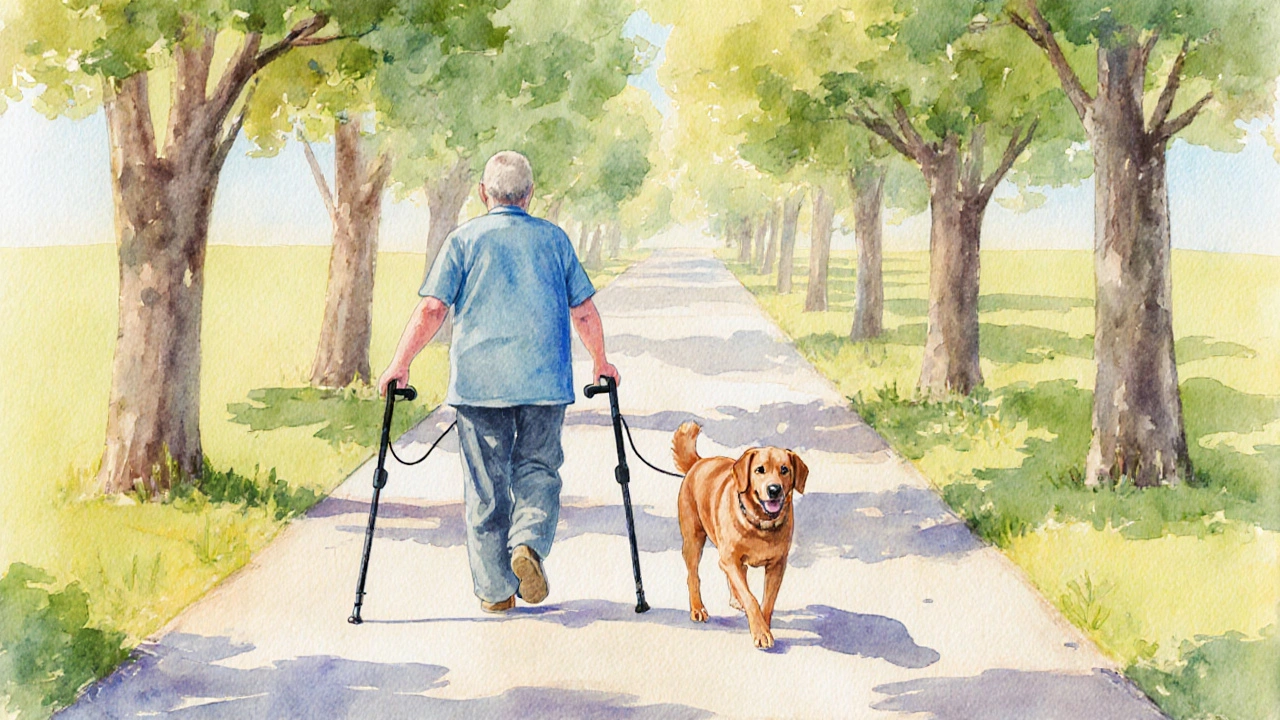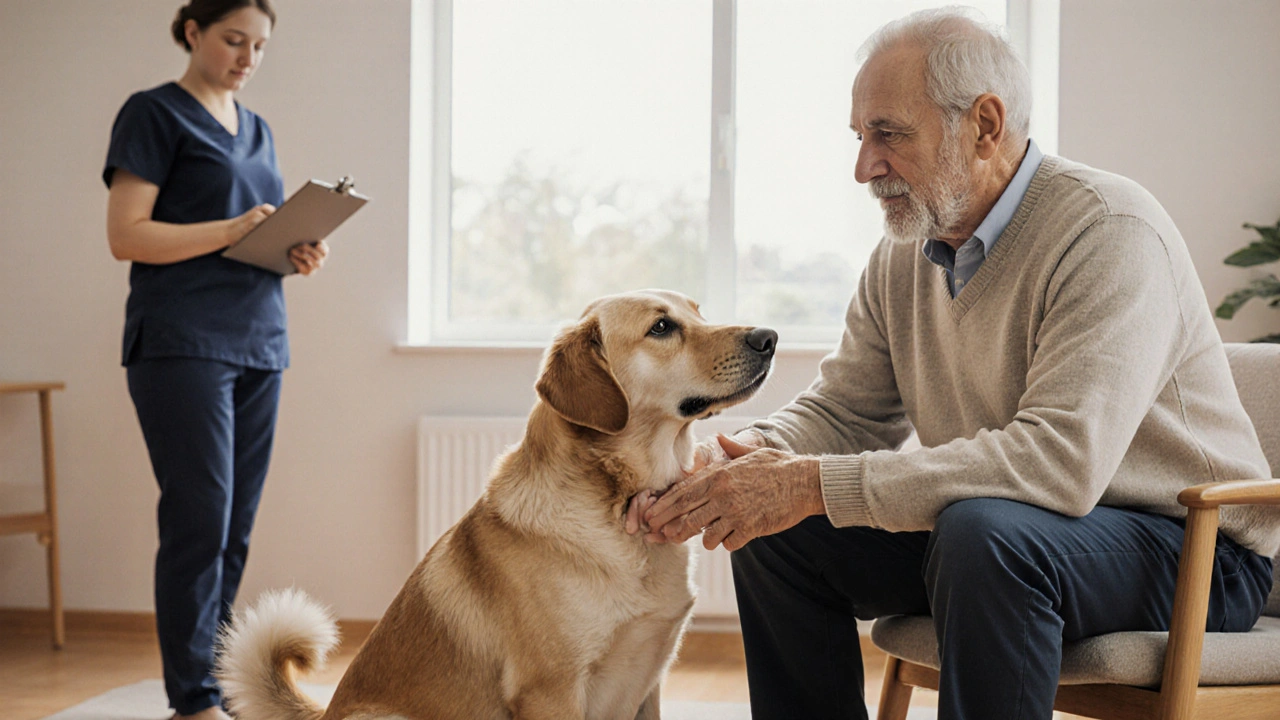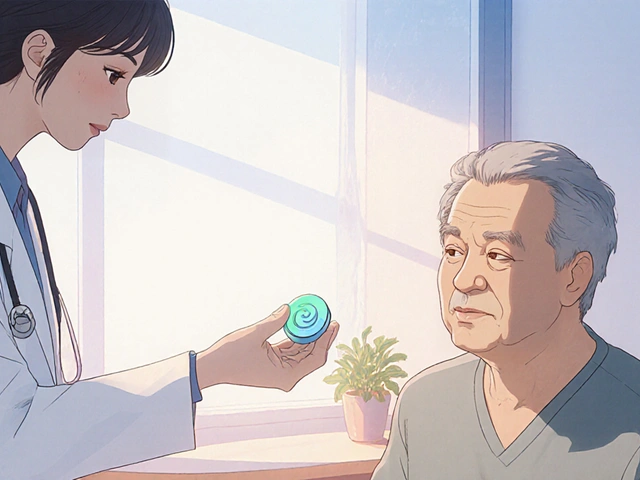Parkinson's Therapy Benefit Estimator
Estimate how animal-assisted therapy might improve your Parkinson's symptoms based on clinical study data. This tool uses research findings from the article to provide personalized estimates.
Estimated Improvements
Enter your current measurements to see estimated improvements.
Results are based on clinical studies showing average improvements:
Gait Speed: +0.12 m/s after 6 weeks
Balance (TUG): -2.5 seconds after 6 weeks
Depression Score: -4.3 points after 8 weeks
Living with Parkinson’s disease brings a mix of tremors, stiffness, and emotional ups and downs that can wear anyone down. In recent years, a surprising ally has stepped into clinics and homes: animals. From friendly dogs wagging their tails to calm cats purring on laps, animal-assisted therapy is proving to be more than a feel‑good extra-it’s a science‑backed tool that can improve everyday life for patients.
Key Takeaways
- Animal‑assisted therapy (AAT) can boost motor function, balance, and gait in Parkinson’s patients.
- Non‑motor symptoms like depression, anxiety, and sleep problems also show measurable improvement.
- Therapy dogs are the most studied, but cats, rabbits, and even horses offer unique benefits.
- Oxytocin release, reduced cortisol, and increased social interaction drive many of the positive effects.
- Implementing AAT safely requires clear goals, trained animals, and coordination with healthcare teams.
What Is Animal-Assisted Therapy?
Animal-Assisted Therapy is a structured therapeutic intervention that incorporates trained animals into a patient’s treatment plan to promote physical, emotional, and social well‑being. Unlike casual pet ownership, AAT follows a defined protocol, measurable outcomes, and professional supervision. Sessions typically last 20-45 minutes and can be conducted in hospitals, rehab centers, or patients’ homes.
Understanding Parkinson’s Disease
Parkinson's disease is a progressive neurodegenerative condition characterized by the loss of dopamine‑producing cells in the substantia nigra. This loss manifests as motor symptoms-tremor, bradykinesia, rigidity, and postural instability-and a suite of non‑motor symptoms such as depression, anxiety, sleep disturbances, and cognitive decline. Managing both fronts is essential for maintaining quality of life.
How Animals Make a Difference
The therapeutic magic starts at a biochemical level. Interacting with animals triggers the release of oxytocin, often called the "bonding hormone," while simultaneously lowering cortisol, the body’s stress hormone. This hormonal shift promotes relaxation, improves mood, and may even enhance neuroplasticity, creating a more receptive environment for physical rehabilitation.

Motor Benefits You Can See
Several small‑scale studies and a few larger trials have documented tangible gains in motor function when AAT is added to standard physiotherapy.
- Improved gait speed: Patients walked an average of 0.12m/s faster after six weeks of weekly dog‑assisted walking sessions.
- Better balance: Timed Up and Go (TUG) test scores dropped by roughly 2.5 seconds, indicating reduced fall risk.
- Enhanced range of motion: Simple roll‑over or reaching exercises performed alongside a therapy dog showed a 15% increase in joint flexibility.
These gains are thought to arise from the animal acting as a moving cue, encouraging patients to initiate steps, maintain posture, and stay engaged throughout repetitive exercises.
Non‑Motor Wins That Matter
Parkinson’s patients often battle anxiety, depression, and sleep problems. AAT targets these areas directly.
- Reduced depressive scores: The Beck Depression Inventory dropped by an average of 4.3 points after an eight‑week AAT program.
- Lower anxiety levels: State‑Trait Anxiety Inventory scores fell by 12% when patients spent 30 minutes daily stroking a therapy cat.
- Better sleep quality: Actigraphy data showed a 30‑minute increase in total sleep time after a month of evening sessions with a gentle‑natured dog.
Beyond numbers, patients report feeling less isolated, more motivated, and eager to participate in other therapies-an indirect boost for overall rehabilitation.
Choosing the Right Therapy Animal
Not every animal fits every patient. Below is a quick snapshot of the most common options and the scenarios where they shine.
| Animal | Primary Strength | Ideal Patient Profile | Special Considerations |
|---|---|---|---|
| Therapy Dog | Motivates movement, provides strong social cue | Patients with gait or balance issues who enjoy walking | Allergy screening, need for outdoor space |
| Therapy Cat | Calm presence, low‑impact tactile stimulation | Individuals with severe tremor or limited mobility | Requires gentle handling, may be shy |
| Therapy Rabbit | Soft texture, encourages fine‑motor hand tasks | Patients in early stages looking to improve hand dexterity | Short sessions, careful hygiene |
| Equine (horse/pony) | Large‑scale movement, core strength building | Fit patients able to handle riding or trotting | Access to stable, higher cost, safety protocols |
Putting Animal‑Assisted Therapy Into Practice
- Set clear goals: Define whether the focus is motor improvement, mood elevation, or both.
- Partner with certified handlers: Ensure the animal holds a current AAT certification and has undergone health checks.
- Integrate with existing treatment: Schedule AAT sessions right before or after physiotherapy to carry forward momentum.
- Monitor outcomes: Use standardized tools (e.g., UPDRS for motor, HADS for mood) every 4 weeks.
- Adjust as needed: If a patient shows fatigue or allergy, switch animal type or modify session length.
Documentation is crucial. Recording session length, animal used, patient response, and any adverse events helps refine the program and provides data for future research.

Safety Tips and Common Pitfalls
While AAT is generally low risk, a few safeguards keep everyone safe.
- Allergy checks: Conduct a simple skin‑prick test before the first session.
- Hygiene protocols: Wash hands before and after contact; ensure animals are groomed and up‑to‑date on vaccinations.
- Animal stress monitoring: Handlers should watch for signs of fatigue or anxiety in the animal and give breaks as needed.
- Patient consent: Explain the process, benefits, and any risks; obtain written consent especially for vulnerable adults.
Skipping these steps can lead to setbacks-like a patient developing a skin rash that forces a pause in therapy, or an animal becoming withdrawn, which reduces effectiveness.
Real‑World Success Stories
At a Bristol neuro‑rehab centre, a 68‑year‑old man with mid‑stage Parkinson’s engaged in twice‑weekly dog‑assisted walking. After three months, his TUG score improved from 22 seconds to 16 seconds, and his self‑reported mood score rose by 20%. He now volunteers to lead a weekly group walk for other patients.
In another case, a former teacher with severe tremor participated in a six‑week cat‑interaction program. She reported a 30% reduction in tremor severity during fine‑motor tasks such as writing, likely due to the calming oxytocin surge during petting sessions.
These anecdotes echo broader research: when animals become part of a multidisciplinary plan, patients often experience gains that exceed what medication or physiotherapy alone can deliver.
Future Directions
Researchers are exploring virtual‑reality animal companions for patients unable to host live animals, and investigating the long‑term neuroprotective potential of regular oxytocin spikes. As evidence builds, insurance providers may start covering AAT as an adjunct therapy, making it more accessible.
Frequently Asked Questions
Can any dog be used for animal‑assisted therapy?
No. Only dogs that have completed a recognized AAT certification program and passed health screenings are suitable. Certified therapy dogs are trained to remain calm, follow commands, and tolerate repeated sessions without stress.
Is animal‑assisted therapy covered by the NHS?
Coverage varies by region and by the specific AAT program. Some NHS trusts pilot AAT as part of multidisciplinary care, but patients often need a referral from a neurologist or physiotherapist. Private insurance is slowly starting to recognize its benefits.
How often should sessions be scheduled?
Most studies use 1-2 sessions per week, each lasting 20-45 minutes. Frequency can be adjusted based on patient stamina, goals, and therapist recommendations.
Are there any risks for patients with severe mobility issues?
Risks are low when sessions are supervised. The main concerns are falls during movement‑based activities and allergic reactions. Proper assessment, use of assistive devices, and a trained handler mitigate these risks.
Can family pets be used instead of certified therapy animals?
Family pets can provide emotional comfort, but they lack the standardized training and health checks required for formal AAT. For clinical outcomes and reimbursement, certified animals are preferred.







Comments
MANAS MISHRA
I think it’s great that the article highlights how animal‑assisted therapy can complement traditional physiotherapy. The hormonal explanations with oxytocin and cortisol are especially helpful for understanding the mechanism. It also gives concrete numbers, like the 0.12 m/s gait speed increase, which makes the benefits feel tangible. For patients who may be hesitant about adding a new therapy, seeing the data can be reassuring. Overall, the piece balances scientific detail with practical guidance nicely.
Lawrence Bergfeld
Solid overview; concise, data‑driven; well‑structured; definitely worth a read!
Chelsea Kerr
🐾 The emotional lift from simply petting a dog or cat can be profound 😌. It’s fascinating how the article ties the oxytocin surge to both motor and mood improvements. I appreciate the clear tables that match patients with the right animal-practical and humane. The future‑direction note on VR companions especially sparks the imagination! 🌟
Tom Becker
Yo, they’re hiding the truth! All these “studies” are funded by pet food giants-don’t trust the hype. Animals might be cute, but they’re not a cure‑all, bro.
Laura Sanders
While the article is thorough it occasionally overstates the impact of AAT – the improvements are modest and should not replace standard treatment protocols